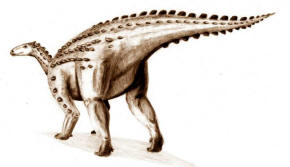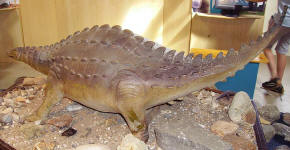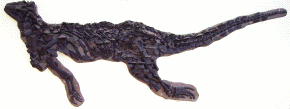|
Comparative anatomist
Richard Owen described
Scelidosaurus in
1859. Only one species, S. harrisonii,
is considered valid today, although other species have been proposed over
the years. One of the most primitive of the thyreophorans, the exact
placement of Scelidosaurus
within the suborder has been the subject of debate for nearly 150 years.
This is not helped by the paucity of knowledge about its closest relatives.
Description
A full-grown
Scelidosaurus was rather small, compared to most
other dinosaurs. Some scientists have estimated a length of 4 metres (13 ft)
Scelidosaurus was
quadrupedal, with the hindlimbs considerably longer than the forelimbs.
It may have reared up on its hind legs to browse on foliage from trees, but
its forefeet were as large as its hind feet, indicating a mostly quadrupedal
posture. Scelidosaurus had four toes, with the innermost digit being
the smallest.
Skull
Unlike later
ankylosaurs, the
skull was low
and triangular in shape, longer than it was wide, similar to that of
primitive
ornithischians. The head of
Scelidosaurus was small, and it had a
neck that was longer than that of most armoured dinosaurs.
Like other thyreophorans,
Scelidosaurus was
herbivorous, with very small, leaf-shaped cheek teeth suitable for
cropping vegetation. It is believed
Scelidosaurus fed with a
puncture-crush system of tooth-on-tooth action, with simple up-and-down jaw
movement. Unlike later ankylosaurs, Scelidosaurus still had the five
pairs of
fenestrae (skull openings) seen in primitive ornithischians, and its
teeth were more leaf-shaped than later armoured dinosaurs.
Armour
The most obvious feature of
Scelidosaurus is its armour,
consisting of bony
scutes embedded in the skin. These osteoderms were arranged in parallel rows down
the animal's body. Osteoderms are also found in the skin of
crocodiles,
armadillos and some
lizards.
These osteoderms ranged in both size and shape; most were small, flat
plates, but thicker scutes also occurred. The scutes were aligned in regular
horizontal rows down the animal's neck, back, and hips, with smaller scutes
arranged on the limbs and tail. The lateral scutes were conical, rather than
the blade-like osteoderms of
Scutellosaurus, and have been used to identify the genus. It also
had a pair of distinctive three-pointed scutes behind the head. Compared to
later ankylosaurs, Scelidosaurus was lightly armoured.
Fossilized skin impressions have also been found. Between the bony
scutes, Scelidosaurus had rounded scales similar to those of a
Gila monster. Between the large scutes, very small (5-10 millimetres
[0.2-0.4 in]) flat "granules" of bone were distributed within the skin. In
later ankylosaurs, these small scutes may have developed into larger scutes,
fusing into the multi-osteodermal plate armour seen in genera such as
Ankylosaurus.
Diet
Scelidosaurus and its Jurassic relatives were herbivorous.
However, while other ornithischians possessed teeth capable of grinding
plant material, Scelidosaurus had smaller, less complex teeth and a
jaw capable of only simple up-and-down jaw movements. In this aspect, they
resembled the
stegosaurids, which also bore primitive teeth and simple jaws. Also like
stegosaurs, they may have swallowed
gastroliths to aid processing of food (because of the lack of chewing
ability), in the same manner used by modern birds and crocodiles. Their diet
would have consisted of leaved plants or fruits, as grasses did not evolve
until late into the
Cretaceous Period, after
Scelidosaurus had become extinct.
Classification
Scelidosaurus was an
ornithischian and has been classified at different times as an
ankylosaur or
stegosaur. This debate is still ongoing; at this time, it is considered
to be either more closely related to ankylosaurids than to stegosaurids and,
by extension, a true ankylosaur, or basal to the ankylosaur-stegosaur split.
The stegosaur classification has fallen out of favor, but is seen in older
dinosaur books. Despite its ankylosaur classification,
Scelidosaurus
shared similarities with
Stegosaurus, including a heavy body highest at the hips and bony
plates down its back.
Scelidosaurus gives its name to the
Scelidosauridae, a
group of primitive ornithischians close to the ancestry of ankylosaurs and
stegosaurs. Aside from Scelidosaurus, other members of the
clade include
Bienosaurus and possibly
Scutellosaurus. Originally proposed by
Edward Drinker Cope in 1869, the family was resurrected by Chinese
paleontologist
Dong Zhiming in 2001 after study of
Bienosaurus, which shares
close affinities with Scelidosaurus. The scelidosaurids have been
found in Early Jurassic formations, and may have persisted into the Late
Jurassic. Their fossils have been found in
China,
England, and Arizona.
Fossil records of thyreophorans more basal than
Scelidosaurus are
sparse. The more primitive Scutellosaurus, also found in Arizona, was
an earlier genus which was facultatively bipedal. A trackway of a possible
early armoured dinosaur, from around 195 million years ago, has been found
in France. Ancestors of these primitive thyreophorans evolved from early
ornithischians similar to
Lesothosaurus during the Late Triassic.
Species
S. harrisonii, described by Owen, is currently the only recognized
species,
based on several nearly complete skeletons. A potential second species from
the
Sinemurian-age
Lower Lufeng Formation,
S. oehleri, was described by D.J. Simmons
in 1965 under its own genus,
Tatisaurus. In 1996
Spencer G. Lucas moved it to
Scelidosaurus. Although the fossils
are fragmentary, this reassessment has not been accepted, and
S. oehleri
is today once again recognized as Tatisaurus.
History
of discovery
While James Harrison of
Charmouth,
England was quarrying the cliffs of
Black Ven (between Charmouth and
Lyme
Regis), possibly for raw material for the manufacture of
cement, in
1858, he found a few fragmentary
fossils of
limb bones. He sent them to Professor
Richard Owen of the
Natural History Museum (originally the
British Museum (Natural History), London). These, with later finds from
the same spot, revealed a nearly complete skeleton.
Scelidosaurus was
named by Sir Richard Owen in 1859; however, a complete description did not
appear until 1863. Unfortunately, mixed in with the
Scelidosaurus
fossils were the partial remains of a theropod dinosaur; this was not
discovered until 1968. In 1888,
Richard Lydekker selected the knee joint as the
lectotype
of Scelidosaurus.
For many years, the enigmatic fossils of
Scelidosaurus caused some
debate over the classification of the genus. Von Zittel (1902), Swinton
(1934), and Appleby et al. (1967) identified the genus as a
stegosaur. In a 1968 paper, Romer argued it was an ankylosaur. In 1977,
Richard Thulborn of the
University of Queensland attempted to reclassify
Scelidosaurus as
an ornithopod similar to
Tenontosaurus or
Iguanodon.
Thulborn argued Scelidosaurus was a lightly built bipedal dinosaur
adapted for running. Thulborn's 1977 theories on the genus have since been
rejected.
In 1968, B. H. Newman applied to have Lydekker's selection of the knee
joint as the lectotype officially rescinded by the
International Commission on Zoological Nomenclature, as the joint was
from a megalosaur. Wells et al. informally reassigned these bones,
consisting of a
femur and partial
tibia, to "Merosaurus"
in 1995.
In 1989, scutes identified as belonging to
Scelidosaurus, which
were found in the
Kayenta Formation (Glen Canyon Group) of northern Arizona, helped to
determine the age of the strata was around 200 million years ago. These
scutes also established a geographic tie-in between Arizona's Glen Canyon
and Europe, where fossils of Scelidosaurus had previously been
discovered. Some scientists have disputed the assignment to
Scelidosaurus,
though.
In 2000, Martill
et al. announced the preservation of soft tissue
in a specimen of Scelidosaurus. These fossils consist of eight
caudal
vertebrae in a cut slab of carbonate mudstone, which was judged to date
from the late
Hettangian to
Sinemurian
stages. Parts of the fossil were preserved in such a way that an
envelope of preserved soft tissue is visible around the vertebrae, and show
the presence of an epidermal layer over the scutes. The authors concluded
that the osteoderms of all basal armoured dinosaurs were covered in a tough,
probably keratinous layer of skin.
In popular
culture
Although
Scelidosaurus is nowhere near as well-known as its sister
taxa Ankylosaurus or
Stegosaurus, the genus has appeared
infrequently in popular media. One instance is in Nintendo's
Jurassic Park III: Park Builder video game, where the player
controls a menagerie of dinosaurs, including Scelidosaurus. The
dinosaur is also one of the main exhibits at the
Charmouth Heritage Coast Centre in
Charmouth,
England.
The center houses both a model and a cast of Scelidosaurus, fossils
of which were collected in the area. The children's show
Harry and His Bucket Full of Dinosaurs features a
Scelidosaurus
named Sid as one of Harry's dinosaur friends.
Return to the
Old Earth Ministries Online Dinosaur
Curriculum homepage.

Shopping
Bay
State Replicas - None
Black
Hills Institute - None
|


